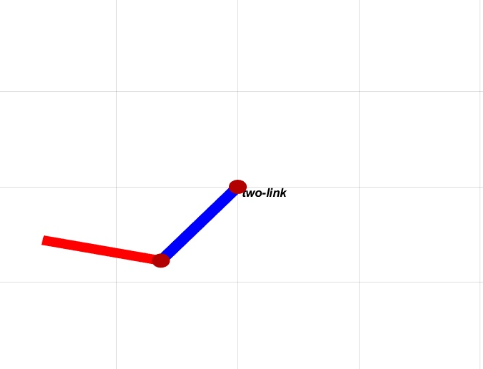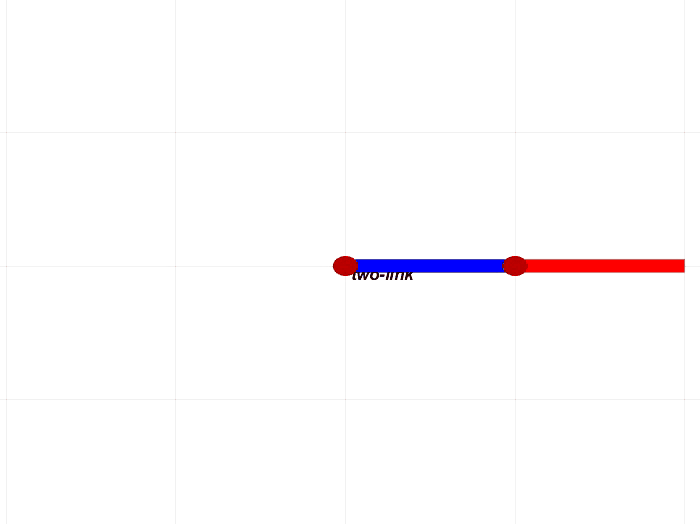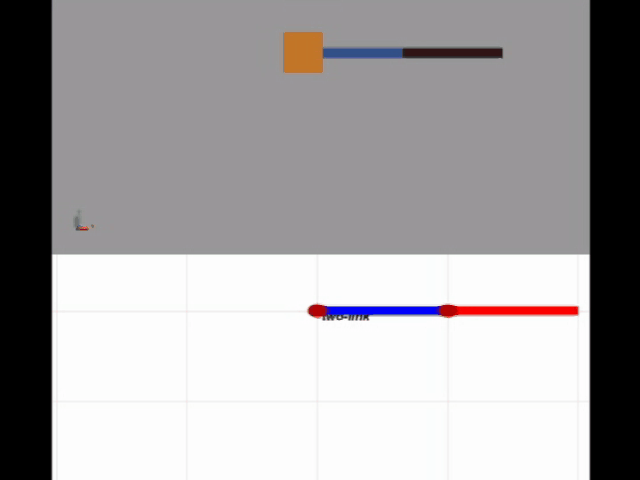

用MATLAB和RTB做二连杆机械臂动力学建模
source link: https://star2dust.github.io/post/matlab-rtb-two-link/
Go to the source link to view the article. You can view the picture content, updated content and better typesetting reading experience. If the link is broken, please click the button below to view the snapshot at that time.

本文使用的工具为MATLAB以及Peter Corke的RTB(Robotics Toolbox)。基于RTB 10.3.1版本,我写了RTE(Robotics Toolbox Extension),增加了一些移动机器人、机械臂以及路径规划相关代码。同时,RTE也修复了原RTB的一些小bug。
听说最近RTB出了10.4,不知道bug修复完没有,有用过的同学可以谈谈感想。个人建议这篇文章最好用我GitHub里的RTE工具箱,下载点这里。安装方法见README文件,写的很详细了。
本文的任务是利用MATLAB和RTB建模二连杆机械臂的动力学,并与MATLAB自带的simulink/simscape仿真进行对比,验证RTB建模的正确性。本文并不涉及控制部分,只是教大家如何建模真实的多刚体系统。
二连杆机械臂
如图1所示,我们要研究的是竖直平面上的二连杆机械臂,也可以说是双摆。因为本文不做控制,所以我们要模拟机械臂在重力的作用下运动的过程。

图1. 竖直平面上的二连杆机械臂
这里给出二连杆机械臂的动力学建模过程[1],之后可以代入数值验证代码正确性。
机械臂的动能为
T(θ,θ˙)=12m1∥v1∥2+12ω1TI1ω1+12m2∥v2∥2+12ω2TI2ω2,(1)T(\theta,\dot \theta)=\frac{1}{2}m_1\|v_1\|^2+\frac{1}{2}\omega_1^T\mathcal I_1\omega_1+\frac{1}{2}m_2\|v_2\|^2+\frac{1}{2}\omega_2^T\mathcal I_2\omega_2,\qquad(1) T(θ,θ˙)=21m1∥v1∥2+21ω1TI1ω1+21m2∥v2∥2+21ω2TI2ω2,(1)
其中,I1\mathcal I_1I1,I2\mathcal I_2I2是关于质心的转动惯量。
分析各连杆关于质心的位置和速度为
xˉ1=r1c1xˉ1˙=−r1s1θ˙1yˉ1=r1s1xˉ1˙=r1c1θ˙1xˉ2=l1c1+r2c12xˉ2˙=−(l1s1+r2s12)θ˙1−r2s12θ˙2yˉ1=l1s1+r2s12xˉ1˙=(l1c1+r2c12)θ˙1+r2c12θ˙2\begin{aligned} \bar x_1&=r_1c_1&\dot {\bar x_1}&=-r_1s_1\dot \theta_1\\ \bar y_1&=r_1s_1&\dot {\bar x_1}&=r_1c_1\dot \theta_1\\ \bar x_2&=l_1c_1+r_2c_{12}&\dot {\bar x_2}&=-(l_1s_1+r_2s_{12})\dot \theta_1-r_2s_{12}\dot \theta_2\\ \bar y_1&=l_1s_1+r_2s_{12}&\dot {\bar x_1}&=(l_1c_1+r_2c_{12})\dot \theta_1+r_2c_{12}\dot \theta_2 \end{aligned} xˉ1yˉ1xˉ2yˉ1=r1c1=r1s1=l1c1+r2c12=l1s1+r2s12xˉ1˙xˉ1˙xˉ2˙xˉ1˙=−r1s1θ˙1=r1c1θ˙1=−(l1s1+r2s12)θ˙1−r2s12θ˙2=(l1c1+r2c12)θ˙1+r2c12θ˙2
其中,r1r_1r1,r2r_2r2是关节离重心的距离。代入式1得,
T(θ,θ˙)=12[θ˙1θ˙2]T[α+2βc2δ+βc2δ+βc2δ][θ˙1θ˙2],T(\theta,\dot \theta)=\frac{1}{2}\begin{bmatrix} \dot \theta_1\\ \dot \theta_2 \end{bmatrix}^T\begin{bmatrix} \alpha+2\beta c_2&\delta+\beta c_2\\ \delta+\beta c_2&\delta \end{bmatrix}\begin{bmatrix} \dot \theta_1\\ \dot \theta_2 \end{bmatrix}, T(θ,θ˙)=21[θ˙1θ˙2]T[α+2βc2δ+βc2δ+βc2δ][θ˙1θ˙2],
α=Iz1+Iz2+m1r12+m2(l12+r22)β=m2l1r2δ=Iz2+m2r22。\begin{aligned} \alpha&=\mathcal I_{z1}+\mathcal I_{z2}+m_1r_1^2+m_2(l_1^2+r_2^2)\\ \beta&=m_2l_1r_2\\ \delta&=\mathcal I_{z2}+m_2r_2^2。 \end{aligned} αβδ=Iz1+Iz2+m1r12+m2(l12+r22)=m2l1r2=Iz2+m2r22。
参考我之前柔性机械臂建模的文章中的拉格朗日运动方程,可得
ddt∂T∂θ˙=[α+2βc2δ+βc2δ+βc2δ][θ¨1θ¨2]+[−2βs2θ˙2−βs2θ˙2−βs2θ˙20][θ˙1θ˙2],∂T∂θ=[0−(βs2θ˙12+βs2θ˙1θ˙2)]=[−βs2θ˙2βs2θ˙1−βs2(θ˙1+θ˙2)0][θ˙1θ˙2]。\begin{aligned} \frac{d}{dt}\frac{\partial T}{\partial \dot \theta}&=\begin{bmatrix} \alpha+2\beta c_2&\delta +\beta c_2\\ \delta+\beta c_2&\delta \end{bmatrix}\begin{bmatrix} \ddot \theta_1\\ \ddot \theta_2 \end{bmatrix}+\begin{bmatrix} -2\beta s_2\dot \theta_2&-\beta s_2\dot \theta_2\\ -\beta s_2\dot \theta_2&0 \end{bmatrix}\begin{bmatrix} \dot \theta_1\\ \dot \theta_2 \end{bmatrix},\\ \frac{\partial T}{\partial \theta}&=\begin{bmatrix} 0\\ -(\beta s_2\dot \theta_1^2+\beta s_2 \dot \theta_1\dot \theta_2) \end{bmatrix} =\begin{bmatrix} -\beta s_2\dot \theta_2&\beta s_2\dot \theta_1\\ -\beta s_2(\dot \theta_1+ \dot \theta_2)&0 \end{bmatrix}\begin{bmatrix} \dot \theta_1\\ \dot \theta_2 \end{bmatrix}。 \end{aligned} dtd∂θ˙∂T∂θ∂T=[α+2βc2δ+βc2δ+βc2δ][θ¨1θ¨2]+[−2βs2θ˙2−βs2θ˙2−βs2θ˙20][θ˙1θ˙2],=[0−(βs2θ˙12+βs2θ˙1θ˙2)]=[−βs2θ˙2−βs2(θ˙1+θ˙2)βs2θ˙10][θ˙1θ˙2]。
上面这第二步推导是真的难,我想了好久才想出来,这说明哥氏力其实表达方式不唯一。
两式相减得到
[α+2βc2δ+βc2δ+βc2δ][θ¨1θ¨2]+[−βs2θ˙2−βs2(θ˙1+θ˙2)βs2θ˙10][θ˙1θ˙2]=[τ1τ2]\begin{bmatrix} \alpha+2\beta c_2&\delta +\beta c_2\\ \delta+\beta c_2&\delta \end{bmatrix}\begin{bmatrix} \ddot \theta_1\\ \ddot \theta_2 \end{bmatrix}+\begin{bmatrix} -\beta s_2\dot \theta_2&-\beta s_2(\dot \theta_1+ \dot \theta_2)\\ \beta s_2\dot \theta_1&0 \end{bmatrix}\begin{bmatrix} \dot \theta_1\\ \dot \theta_2 \end{bmatrix}=\begin{bmatrix} \tau_1\\ \tau_2 \end{bmatrix} [α+2βc2δ+βc2δ+βc2δ][θ¨1θ¨2]+[−βs2θ˙2βs2θ˙1−βs2(θ˙1+θ˙2)0][θ˙1θ˙2]=[τ1τ2]
重力和摩擦力很简单,它们都只与θ\thetaθ相关,与θ˙\dot \thetaθ˙无关,这里就省略了。
RTB建模
- 给出物理参数
lx = 1; lr = 0.1; % 连杆的长度和半径
gy = 9.81; % 重力加速度(这里在y轴方向,因为z轴是关节转动轴)
fvis = 0; fcou = 0; % 粘性摩擦系数和库伦摩擦系数
- 建立连杆模型
这里的Cuboid和Cylinder都是我自己基于RTB写的类。
rod = Cuboid([lx,lr,lr]); % 建立成长方体
Irod = rod.inertia; % 可以直接获得转动惯量
这里建立成圆柱也行,获得转动惯量时需要进行一个刚体变换。
rod = Cylinder(lr,lx);
Rcyl = SO3.rpy([0 -pi/2 0]);
Irod = Rcyl.R*rod.inertia*Rcyl.R';
- 机械臂建模
% 设定dh参数,质量,关节质心距离,关节约束,转动惯量,摩擦系数
dpm = {'a', lx, 'm', rod.mass, 'r', [-lx/2,0,0],...
'qlim', [-pi/2, pi/2],'I', Irod,...
'B', fvis, 'Tc', [fcou -fcou]};
% 建立二连杆机械臂,设定回转关节和重力
r = SerialLink([Revolute(dpm{:}),Revolute(dpm{:})],...
'name','two-link','gravity',[0 gy 0]);
经过以上步骤,二连杆机械臂建模完成,设置关节角qz,可以画出机械臂,效果如图1所示。
ws = [-4 4 -4 4 -4 4]; % 设置工作空间
plotopt = {'workspace', ws, 'nobase', 'notiles', 'noshading', 'noshadow', 'nowrist','top'}; % 设置绘图参数
h = r.plot(qz,plotopt{:});
仿真与验证
我们这里验证二连杆机械臂在重力作用下运动过程,即双摆实验。
% 给定初始关节角位置和速度
qz = zeros(1,2);
qd = zeros(1,2);
% 设定仿真时间10s
y0 = [qz,qd]'; tspan = [0 10];
% 刚体仿真用ode15s比较快,用accel函数直接获得关节加速度
tic
[tlist,ylist] = ode15s(@(t,y) [y(r.n+1:end);r.accel(y(1:r.n)',y(r.n+1:end)',zeros(1,r.n))],tspan,y0);
toc
% 差不多6s可出结果,然后画出机械臂即可
ws = [-4 4 -4 4 -4 4];
plotopt = {'workspace', ws, 'nobase', 'notiles', 'noshading', 'noshadow', 'nowrist','top'};
h = r.plot(ylist(:,1:r.n),plotopt{:});
实验结果如下图所示。
下面进行simulink/simscape的双摆仿真,对比实验如下图所示,可以看到前面几乎是同步的。

如何使用simscape搭建一个双摆系统,可以参考b站这个视频。
本文所需全部源代码已上传至我的GitHub,点击这里下载。运行two_link_test.m即可。使用前请确认RTB已经正确安装,下载和安装说明点击这里。
使用simulink/simscape做的双摆仿真也在该仓库里,见link_test.slx,但是需要MATLAB里有simscape的工具箱,否则打不开。另外MATLAB版本最好在2018b以上。
如果喜欢,欢迎点赞和fork。
Murray, R. M. (1994). A mathematical introduction to robotic manipulation. CRC press. ↩︎
Recommend
About Joyk
Aggregate valuable and interesting links.
Joyk means Joy of geeK